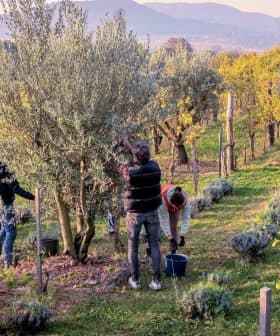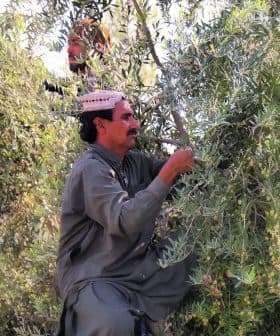Turkey's Production Plummets After Last Year's Record Harvest
Adverse weather, a poor fruit set and an ‘off-year’ have led to a meager yield.
Turkey’s olive oil production for the 2023/24 crop year is significantly lower than the previous year due to unfavorable weather conditions, with an estimated yield of 180,000 tons. The reduced yield has led to a rise in olive oil prices in Turkey, impacting both producers and consumers in the market.
With the initial forecasts of a weak harvest for the 2023/24 crop year confirmed,
Turkey is yet another Mediterranean producer to experience a drastically reduced olive oil yield this season.
The official harvest estimate released by the Turkish Olive and Olive Oil Council (UZZK) in September predicted Turkey’s national olive oil production would reach a mere 180,000 tons this crop year.
The United States Department of Agriculture (USDA) also revised Turkey’s production total to 190,000 tons from an initial estimate of 280,000 tons due to unfavorable climatic conditions, which impacted production.
In the previous 2022/23 crop year, Turkish producers enjoyed a record yield of 421,000 tons of olive oil. However, erratic weather last spring, which extended winter-like conditions in many of the country’s olive oil-producing regions, disrupted the fruit setting of olive trees.
See Also:2023 Harvest UpdatesThis, combined with an ‘off-year’ in the trees’ natural alternate bearing cycle, significantly reduced production.
“It is in the genetics of the olive tree that there will be a much lower production after such a year,” said Mustafa Tan, the UZZK president, commenting on the country’s decreased crop. “Compared to last year, the yield per tree decreased by 55.7 percent to 7.9 kilograms [of olive oil].”
“We expect the estimated yield of olive oil to be 179,300 tons and 442,000 tons of table olives in this production season,” Tan added. “This is a figure that can cover both our exports and our consumption in the domestic market.”
From Ayvalik, a well-known olive oil-producing region on the northwestern Aegean coast, Mustafa Kürlek of Köklü Zeytincilik said the country’s olive oil production fared lower than the official estimates.
“For the 2023/24 season, the Turkish National Olive Oil Assembly estimated the overall output at 180,000 tons, whereas the actual output remained at 120,000 tons,” Kürlek told Olive Oil Times.
However, he noted that the previous harvest’s carryover stock has adequately supplemented this year’s lower yield.
“A quantity of 100,000 tons of olive oil from the 2022/23 season has been added to the 2023/24 overall output,” he said. “The quantity of olive oil available in Turkey, especially the internationally accepted extra virgin olive oil, is sufficient.”
Kürlek added that the three-month export ban imposed on bulk olive oil in August harmed Turkish exporters and international markets.
The export prohibition, initially scheduled to last until last November, has been extended indefinitely in Turkey over concerns about shortages in the domestic market.
“I assume that there is a 25 percent probability that the ban will be lifted in March, but I think this is more likely to happen next September,” Kürlek added.
As in other producing countries, a characteristic of this harvest season in Turkey is the contrast between declining yields and increased olive oil prices in the main producing regions.
In Mut, a district in the Mersin province on Turkey’s southern coast and home to about 21 mills, production fell sharply to 5,000 tons of olive oil from around 30,000 tons last year. However, the high olive oil prices have compensated local farmers for the reduced crop.
“The yield was lower compared to last year,” said Muharrem Yılmaz of the local chamber of agriculture. “The reason for this is that the weather was a little dry compared to last year. The trees could not be watered sufficiently; in other words, it was a dry year.”
“[A liter of] olive oil, which went for 80 lira (€2.38) to 100 lira (€2.97) last year, is sold for 250 lira (€7.43) to 350 lira (€10.40) this year,” he added. “This has made producers smile, even though production was small.”
However, the pattern of reduced yields is not uniform across the country, with some Turkish producers able to repeat last year’s production volumes, albeit with a reduced quality.
“As expected, the season was not spectacular,” said the owners of Olive811, who grow 15,000 olive trees of the Domat and Ayvalik varieties in the northwestern region of Çanakkale. “Nevertheless, the harvest was close to last year’s quantity. Having a high number of trees tends to lower the effect of seasonality.”
“The quality of olive oil is slightly lower than last year,” they added. “We always had 0.2 to 0.4 percent maximum acidity, and this year, we got up to 0.4 to 0.6 percent. The overall quality of olive oil in the region was definitely worse, hardly graded as extra virgin.”
Meanwhile, and as much as the high prices have benefitted producers, some consumers in Turkey are in dire straits when buying olive oil.
“Although we live among olive trees here, we cannot bring olive oil to our tables,” said Mehmet Kaygi, a retiree living in Soma in the Manisa province, one of the country’s main olive oil-producing regions. ”Even in Soma, olive oil now costs 300 lira (€8.88). We have now started using sunflower oil.”
According to Can Candeger, a managing partner at Artem Oliva, one of Turkey’s largest olive oil producing and exporting companies, the reduced 2023/24 yield, combined with domestic and external factors, is behind the rise of olive oil prices in Turkey.
“The 2023/24 season witnessed a decrease in overall olive oil production compared to previous years, exacerbating the market’s tightness,” Candeger told Olive Oil Times.
“The low yields, inflation and pressured exchange rates of the Turkish lira have contributed to the upward trend in olive oil prices in Turkey,” he added. “The rising prices in Spain also have a ripple effect, pushing up Turkish olive oil prices.”
Candeger was also cautiously optimistic about the next 2024/25 crop year, pointing out that safer conclusions will be drawn in early summer.
“We have higher expectations about the upcoming 2024/25 season compared to the current one,” he said. “However, it will not be clear until next June how the new season will unfold. Around that time, the blossoming of the olive trees in the country will provide a preliminary projection about the potential yield performance.”
Share this article









